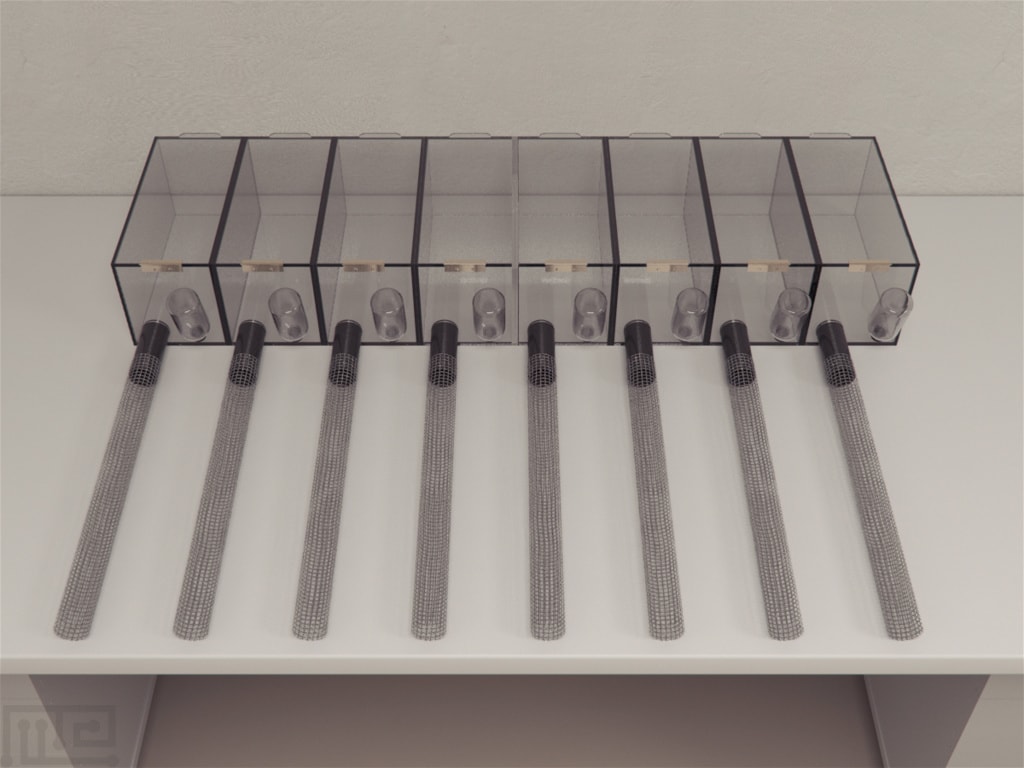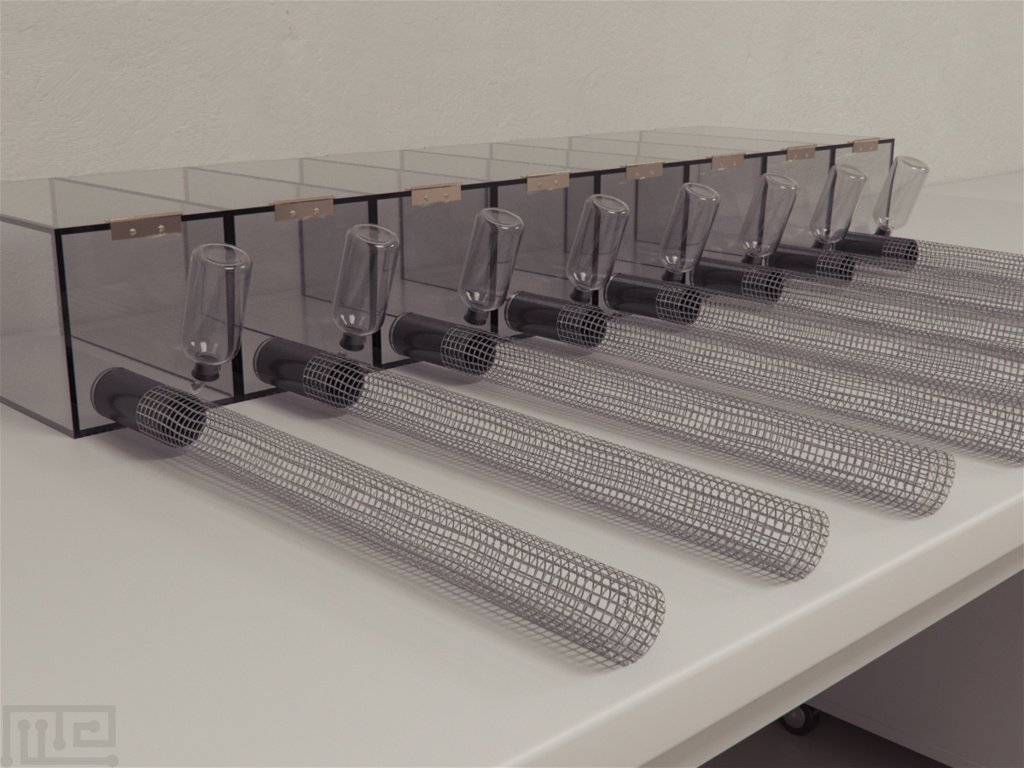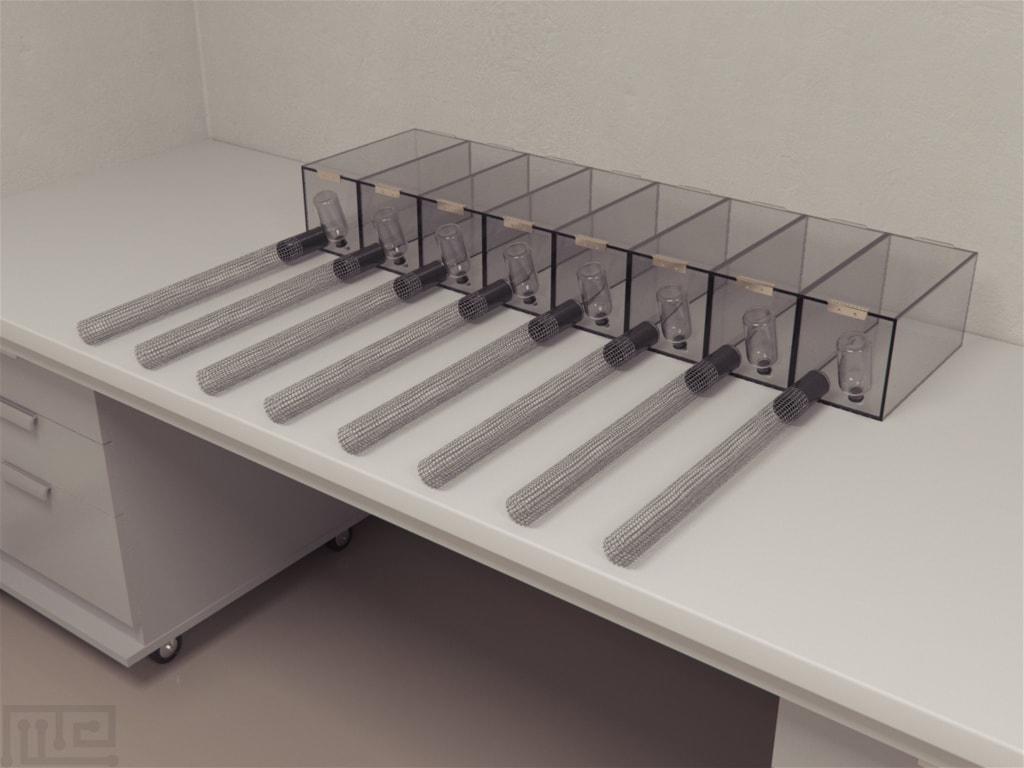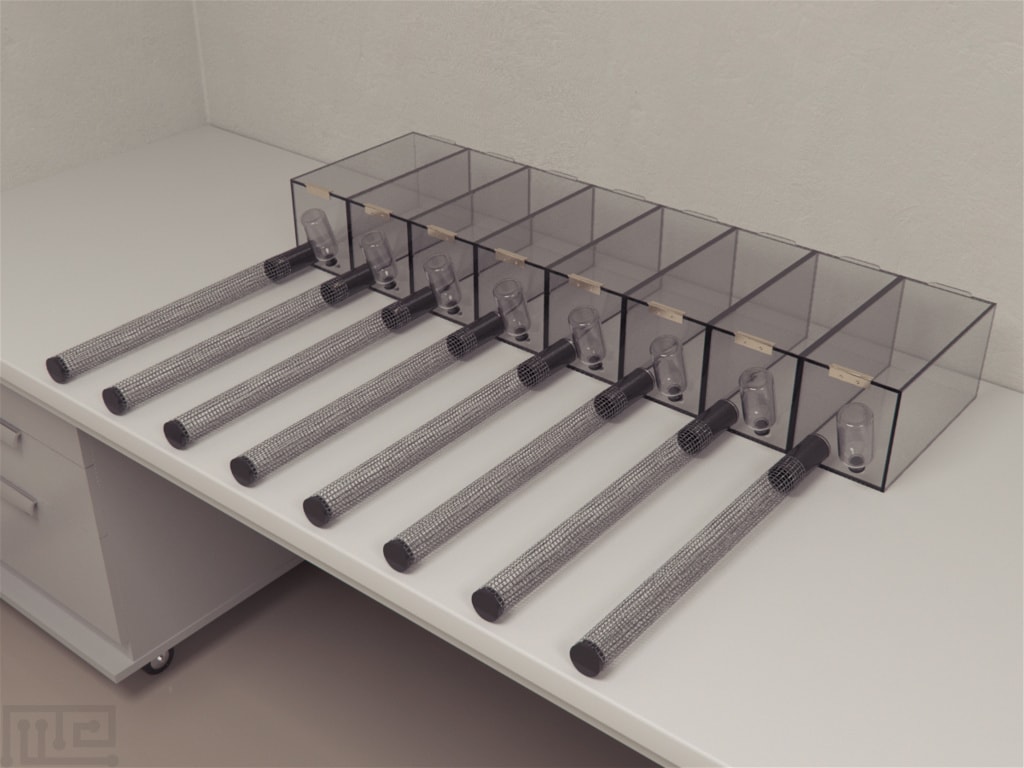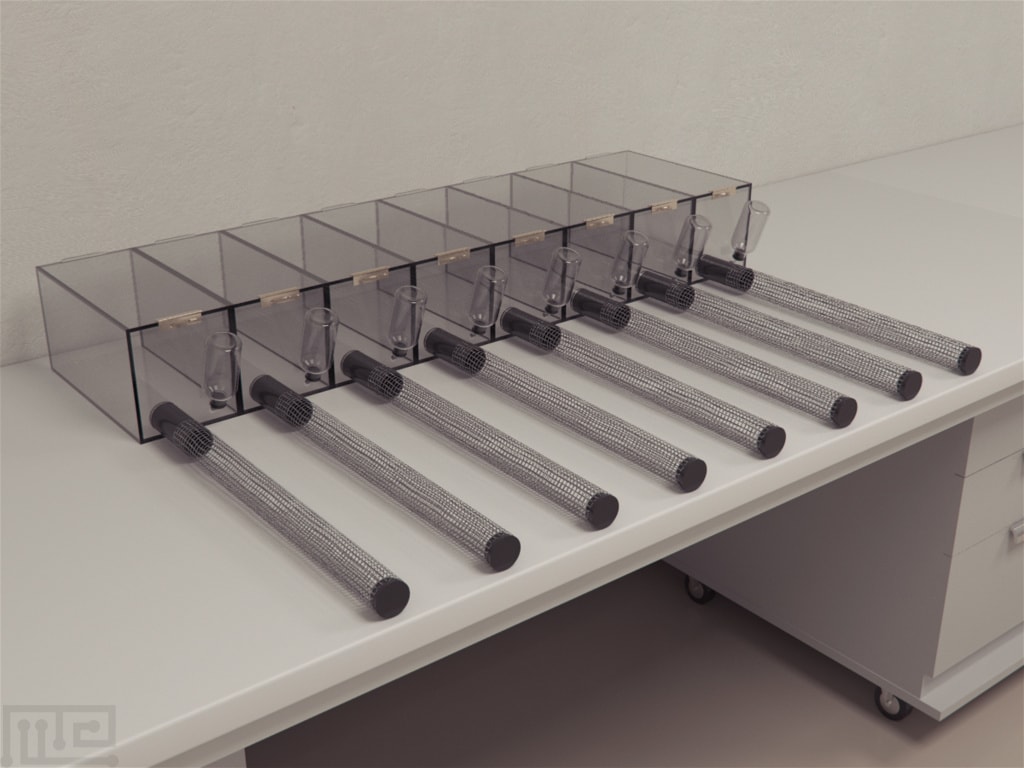Hoarding behavior has been described in many places in the literature, however this variant reviewed by Deacon (2012) is the standard offered by MazeEngineers. It consists of 8 rows with a removable clear lid, with an acrylic tube connected to 8 separate wire mesh tubes with a removable end. Sizing for mice and rats. Multiple colors available.
Hoarding apparatus is used to study a species-typical behavior manifested by transferring the food to secure place for later consumption. In nature, animals either hide food underground like squirrels and birds or near home base in burrows like rodents. Hoarding behavior is considered useful for animals in situations like extreme weather changes or when hiding from predators. Hoarding food rather than consuming and storing it as fat is thought to be more energy efficient because fat storage can increase body mass, decrease ambulation and increase chances of predation. Factors like spoilage or theft of food can affect the hoarding behavior. (Keen-Rhinehart et al., 2010).
Price & Dimensions
Mouse
$ 2390
One Device- Home Chamber (8)
- Length: 30cm
- Width: 13cm
- Height: 15cm
- Transparent removable lid
- Water bottle
- Hoarding Tube
- Length: 10cm
- Diameter: 4cm
- Wire Mesh tube
- Length: 45cm
- Diameter: 4cm
- Total Length: 50cm
Rat
$ 1990
One Device- Acrylic Rows
- Length: 45cm
- Width: 22.5cm
- Height: 22.5cm
- Transparent removable lid
- Water bottle
- Hoarding Tube
- Length: 15cm
- Diameter: 6cm
- Wire Mesh tube
- Length: 67.5cm
- Diameter: 6cm
- Total Length: 75cm
Documentation
Introduction
Craig et al., first described food hoarding while describing behaviors involved in eating, drinking, and reproduction. One of the behaviors described was ‘appetitive ingesting behavior’ which is a species-specific motivated behavior towards achieving a certain goal object. Food hoarding is one of the appetitive ingestive behaviors. Rats are not natural hoarders and only carry food from one place to another to consume it. In laboratory settings, however, rodents depict hoarding behavior when the access to food is restricted or completely stopped. Wolfe et al., conducted one of the first studies to show food hoarding, then described as food-storing behavior in laboratory rats and how this behavior is affected by habits and diet. Later on Morgan et al., stated a deficit hypothesis that animals show hoarding behavior when they reach a certain threshold of energy deficit. They tested this hypothesis by observing how food deprivation and satiation affects food hoarding in rats. Deacon ., described a simple and easy to use apparatus to assess hoarding in mice which is one of the standard protocols used at present to study hoarding in rodents.
The hoarding apparatus consists of 8 rows of home chambers, each connected to a hoarding tube made up of wire mesh, and a small section of the plastic tube. The distal end of the wire mesh tube is closed after placing the food pellets at the distal end using a wooden plug. The proximal end of the hoarding tube can also be closed to prevent the subject from entering the tube when the experiment is not being conducted. The subjects are allowed into the hoarding tube, and the pellets moved into the home chamber are weighed at the end of the test.
Apparatus and Equipment
The hoarding apparatus is made up of 8 rows of connecting home chambers, each connected to a hoarding tube. Each home chamber is made up of acrylic glass with a removable transparent lid and a water bottle attached to it. The hoarding tube connected to each home chamber is made up of acrylic and 6mm wire mesh. The size of the chamber and hoarding tube will vary according to the animal under study. For mice, the chamber is 30 cm × 13 cm × 15 cm and the hoarding tube is 50 cm (acrylic part 10 cm/wire mesh 45 cm) long with a diameter of 4 cm. For rats, the chamber is 45 cm × 22.5 cm × 22.5 cm in size and the hoarding tube is 75 cm (acrylic part 15 cm/wire mesh 67.5 cm) long with a diameter of 6 cm. The proximal and the distal end of the hoarding tube can be closed with a removable wooden plug of appropriate diameter.
Training Protocol
The subjects are housed in groups of 3–5 in plastic cages with wood chip bedding in rooms with a 12-hour light-dark cycle. Before starting the test, clean the home chambers and hoarding tubes to remove the presence of any unwanted stimuli from influencing the performance. Transfer some of the soiled wood chip bedding from group cages into the home chamber and plug the proximal end of the hoarding tube.
Weigh 100 grams of food pellets and place them at the distal end of the hoarding tube closing it with the wooden plug. Place one subject in each of the 8 home chambers at the start of the light phase. Remove the wooden plug from the proximal end of the hoarding tube before the start of the dark phase so that the subject can access the tube. The next day at the start of the light phase, collect the food pellets from the home chamber and weigh them. Return the subject back into their group cage.
Repeat the test multiple times for the subjects to become habituated. The test is then repeated as described above after administration of the treatment under study.
Evaluating exploratory study of food-storing in rats
A study was conducted in well-fed rats to observe how diet and habits affect food-storing behavior by Wolfe et al. The group of rats that were fed pellets from a young age showed food-storing behavior greater than the group of rats that were fed powder consistently over 10 days of testing. It was also observed that greater the food deprivation, greater the amount of food stored.
Evaluation of food-deprivation and hoarding in rats
Morgan et al., carried out first of its kind experiments with rats to observe the influence of food-deprivation and satiation on food hoarding behavior. Four different experiments were conducted with increasing hours of food deprivation. The observations made during the study showed that the rats when deprived of food for 24 hours with only 1 hour to eat, did not show any immediate hoarding behavior, but once the behavior was shown, the duration of food-deprivation did not affect the intensity of hoarding. There was a circadian rhythm to the hoarding behavior in rats. It was concluded that the aim was not to collect food pellets but instead to carry out the hoarding activity.
Evaluation of hoarding behavior elicited by electrical stimulation
Herberg et al., applied electrical stimulation to lateral hypothalamus, specifically areas that stimulate feeding. It was observed that non-hungry rats showed intense hoarding behavior when electrically stimulated. This behavior is also shown by rats when they are deprived of food for longer time periods. The study suggests that hypothalamus is involved in producing hoarding behavior as a result of long-term nutritional deficiency.
Assessing hoarding behavior in mice
Deacon et al., studied hoarding behavior in mice using a simple and easy to build apparatus. The study concluded that hoarding is a species-typical behavior which can be used to observe effects of brain lesions and different pharmacological treatments in multiple strains of genetically modified mice.
Evaluating burrowing, nest construction, and hoarding in mice
Deacon., continued their work with further developing a hoarding paradigm to characterize “activities of daily living” (ADL) in mice which can be used to understand the neurodegenerative diseases like Alzheimer’s disease (AD) further. The study used female C57BL/6 genetically modified mice that underwent stereotaxic surgery to produce hippocampal and prefrontal cortex lesions. It was observed that the mice with hippocampal lesions did not show hoarding behavior as compared to mice with prefrontal cortex lesions that had a very little effect on hoarding behavior.
Sample Data
The following data is collected from the experiment
- Mass of the food pellets moved into the home chamber from the hoarding tube.
Strengths & Limitations
Strengths
The Hoarding apparatus is simple and easy to use. It can be used to characterize ADL in rodents which can be translated to human ADL and further our knowledge about Alzheimer disease. The apparatus can be modified in size to study hoarding behavior in other small mammals. It can be used to identify the underlying brain regions involved in food hoarding behavior or identify conditions that affect hoarding behavior.
Limitations
The data obtained from the apparatus is mostly non-parametric.
Summary and Key Points
- Hoarding apparatus is used to study a species-typical behavior manifested by transferring the food to secure place for later consumption.
- The Hoarding apparatus consists of 8 rows of home chambers, each connected to a hoarding tube made up of wire mesh and a small section of the plastic tube.
- The subjects are allowed into the hoarding tube, and the pellets moved into the home chamber are weighed at the end of the test.
- The Hoarding behavior can be used to characterize “activities of daily living” (ADL) in mice which can be used to further understanding of neurodegenerative diseases like Alzheimer’s disease (AD).
- The Hoarding apparatus is simple, easy to use and can be modified in size to study hoarding behavior in other small mammals apart from rodents.
References
Craig W (1918). Appetites and Aversions as Constituents of Instincts. The Biological Bulletin 34(2), 91-107. DOI: 10.2307/1536346
Wolfe JB (1939). An exploratory study of food-storing in rats. Journal of Comparative Psychology, 28(1), 97-108. DOI: 10.1037/h0060894
Morgan C. T, Stellar E, & Johnson O (1943). Food-deprivation and hoarding in rats. Journal of Comparative Psychology, 35(3), 275-295. DOI: 10.1037/h0056707
Herberg LJ, Blundell JE (1967). Lateral hypothalamus: hoarding behavior elicited by electrical stimulation. Science, 155(3760), 349-50. DOI: 10.1126/science.155.3760.349
Deacon RM (2006). Assessing hoarding in mice. Nature Protocols 1(6), 2828-30. DOI: 10.1038/nprot.2006.171
Keen-Rhinehart, Dailey MJ, Bartness T (2010). Physiological mechanisms for food-hoarding motivation in animals. Philos Trans R Soc Lond B Biol Sci., 365(1542), 961-75. DOI: 10.1098/rstb.2009.0225
Deacon RM (2012). Assessing burrowing, nest construction, and hoarding in mice. J Vis Exp. 59, e2607. DOI: 10.3791/2607.

